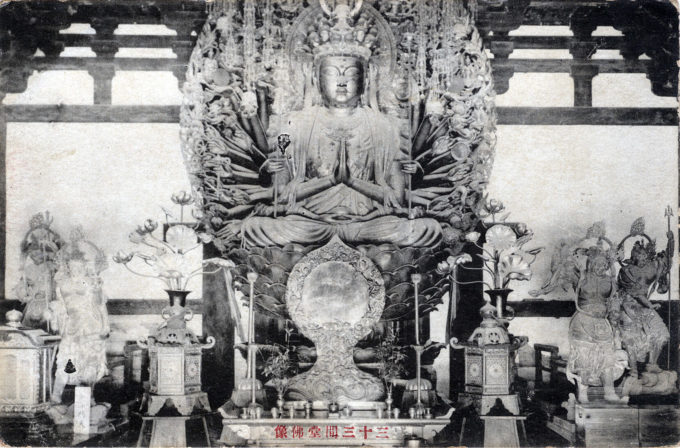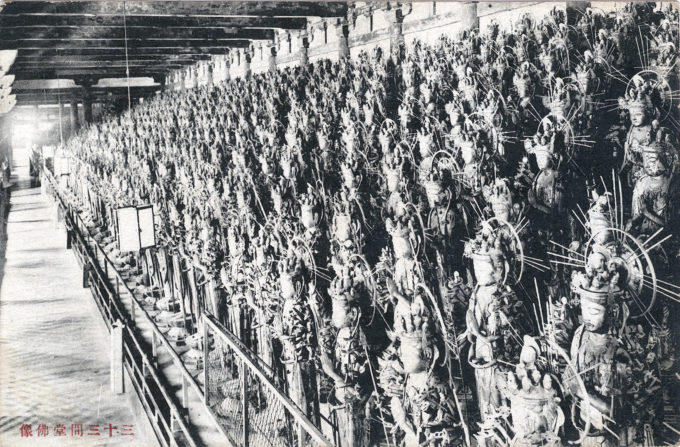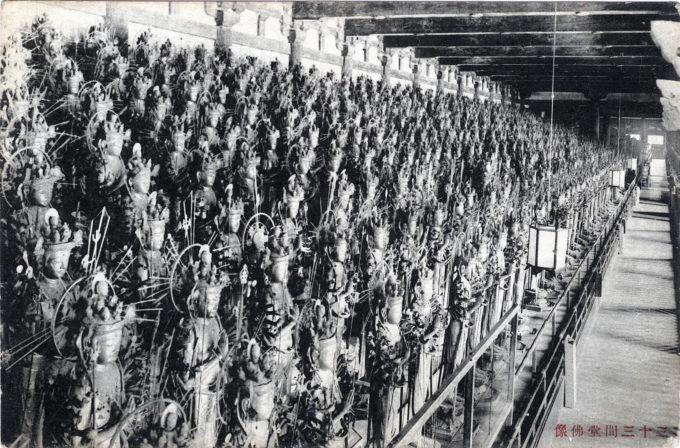
The Temple of the 33,333 images of Kwannon, the Goddess of Mercy, at Sanjūsangen-dō, Kyoto, c. 1920. Sanjūsangen-dō dates from 1266 (the Kamakura Period) and is designated a National Treasure of Japan. (Gift of J. Harper Brady Sr.)
“Quite unique is the impression produced by this immensely elongated edifice, with its vast company of gilded images rising tier above tier. Each image is 5 ft. high, and all represent the Eleven-faced Thousand-handed Kwannon.
“There are 1,000 of these, the total number of 33,333 being obtained by including in the computation the smaller effigies on the foreheads, on the halos, and in the hands of the larger ones.
“Three hundred of the large images were executed by Kökei and Kõei, two hundred by Unkei, and the remainder by Shichijö Dai-busshi. Though all represent the same divine personage, it will be found that in spite of the general resemblance, no two have quite the same arrangement of hands and articles held in them.
“The large seated figure in the centre is also a Kwannon, while standing round it are Kwannon’s ‘Eight-and-twenty Followers’ (Bushū).”
– A Handbook for Travellers in Japan, by Basil Hall Chamberlain & W.B. Mason, 1901
- Sanjūsangen-dō, Kyoto, c. 1920. (Gift of J. Harper Brady Sr.)
- Sanjūsangen-dō, Kyoto, c. 1920. (Gift of J. Harper Brady Sr.)
“The San-jũ-san-gen-do (Thirty-three Ken Hall ) is celebrated for its Thousand and One Statues of the Goddess Kwannon, and derives its name from the two massive interior roof-beams each 33 ken long.
“The weather-beaten, barn-like structure (the property of the Tendai sect of Buddhists) is 53 ft. wide by nearly 400 ft. long; has a 6 ft. platform running quite around it, and is divided into 35 spaces delined by 36 upright columns sheathed in rusted iron, with 5 spaces at each end.
“When the old building burned in 1249, the 2002 images it is said to have contained perished with it, but in 1266 the Emperor Kameyama assembled 1001 new figures and housed them in the present building – which was practically reconstructed by the 4th Tokugawa shogun, Ietsuna, in 1662.
“The numerous pits and slits in the beams of the back platform are relics of a time when the priests in charge were fond of archery and used to practice here the aim being to shoot an arrow from one end of the structure to the other.”
– Terry’s Japanese Empire, T. Phillip Terry, 1914



